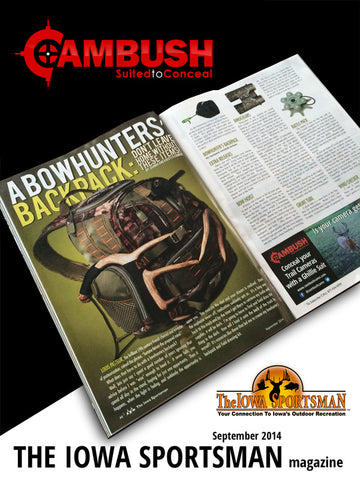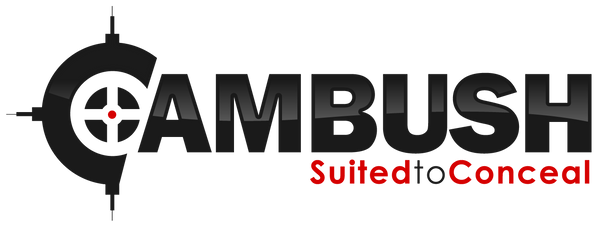A Bowhunters' Backpack: Don't leave home without these items!
August 21 2014 – Shawn OConnor
 We hope you enjoy our fourth article in this months Iowa Sportsman magazine, "A Bowhunters' Backpack: Don't Leave Home Without These Items".
We hope you enjoy our fourth article in this months Iowa Sportsman magazine, "A Bowhunters' Backpack: Don't Leave Home Without These Items".
Louis Pasteur, the brilliant 19th century French chemist and inventor of pasteurization, coined the phrase, "fortune favors the prepared mind.
What does that have to do with a bowhunters backpack?
Well, lets just say I spent a good number of years ignoring that advice before I was "wise" enough to heed it. It never fails; you spend all day in the stand, hoping for just one opportunity. Then it happens, when the light is fading, and suddenly the opportunity is upon you. You execute the shot and your dream is realized. Once the euphoria wears off, realization suddenly sets in. It’s a long way back to the truck and by the time I get there to retrieve my knife and supplies, it will be dark. I'm going to have to find and field dress this thing in the dark. How will I load it onto the back of the truck by myself? It's scenarios like these that led me to create my bowhunter’s backpack and field dressing kit.
At the beginning of each fall, I gather all the necessary supplies and throw them in my pack to keep with me wherever I hunt. It's portable, lightweight and includes only the most important items to have within reach while waiting for the perfect shot and then to quickly dress a deer.
Bowhunter’s Backpack
My backpack essentials include:
Extra Releases
Have you ever dropped your release from the stand? Everyone has at one time or another. Now imagine you drop your release as Mr. Big is approaching. Having a duplicate release is a good habit to get into. You just never know when your primary release will fail or you leave it back in the bow case at the truck.
Bow Hoist
Always use a hoist to lift all your gear in and out of the stand! Never wear your bow or backpack while climbing up or down the tree. Your body may not be able to control the extra weight if something should go wrong, and you want two hands free for safety. About any rope will work for a hoist. I like to use a thicker rope with a carbineer. This allows me to secure my gear quietly and quickly, and the thicker rope prevents the line from digging into my hands when hoisting or lowering.
Binoculars
I like ten-power binoculars. Some guys prefer eight-power for the wider field of view. You want a quality pair of binos in the field, especially in low light conditions so you can accurately identify deer in cover. The old adage “you get what you pay for” never rings truer than in optics. Your binos should be at the ready the entire hunt. I like to use the bino buddy. This keeps my binos secured to my chest and out of the bowstring, and I can instantly raise them up to investigate.
Wind Checker
I use a wind checker constantly. There are many types on the market, but I prefer a powder that floats on the wind current to indicate direction. I use it every half hour to make sure the wind hasn’t changed on me. On more than one occasion I’ve changed stands after seeing the wind changed to an undesirable direction.
Pruning Saw
I tuck one of these in my pack to clear a stray limb that might impede my shooting line. I like a compact unit that folds in half. I’ve used several types in the past, and all broke after a season or two. Then I came across the Wicked Tree Saw. This thing is built for abuse and is one fine piece of equipment. Their Tree Pack saw comes with a case that conveniently attaches to your backpack. It’s a great saw; they even have the saw in a pole pruning version.
SD Cards
I always keep a couple SD cards in my pack just in case I want to change out the cards in my trail cameras. Be sure they’re the correct size and type for your cameras. I find it convenient to change out my camera cards as I’m on my way in or out of the stand.
Allen Wrench
You never know when this tiny tool might come in handy to tighten a loose screw on your bow.
Field Dressing Kit
In a separate plastic baggie, I gather the following items for my field dressing kit. I place this baggie in my pack, and I’m ready to dress a deer at a moment’s notice. My field dressing kit consists of:
Sanitizing Wipes
The kind that come in the small foil packs, like you would get when you visit a bbq rib joint. You can find them at any pharmacy. The wipes are used to clean up your knife, saw and you after the job is done. You'll also be glad you have them when nature calls out in the woods.
Nitrile Gloves
I keep several pairs of these in my kit. If I have a buddy helping me, I've got an extra set for him to use. I like the nitrile gloves because they are puncture resistant and don't tear easily. They are also latex free, so if I have a buddy borrowing a pair, I don't have to worry about him having a reaction if he is allergic to latex. When done field dressing I take off one glove, place it in the palm of my other hand that still has the glove on, place any trash in my palm and then remove the remaining glove by turning it inside out. This keeps the trash together and enables me to pack out the trash and dispose of it properly. The gloves also pull double duty, the same way the sanitizing wipes do. No sense getting your hands dirty, especially when you packed a lunch for the all-day sit and you'll be eating later in the day.
LED Headlamp
A good headlamp is an invaluable tool. I like headlamps that utilize LED’s for illumination, this way I don't have to worry about the bulb burning out. The headlamp can be used walking in to your stand in the morning or during blood trailing. While field dressing, it puts light right where you want it and keeps both of your hands free. I also like to select headlamps that use the same size battery as my trail cameras. If the battery goes dead on the headlamp, all I have to do is go to my nearest camera and "borrow" a battery.
Surgically sharp knife
The key to a quick field dressing is to use a sharp knife, and I mean surgically sharp blade. I've tried many different types of knives over the years. They all did the job but the problem was that the knife didn’t stay sharp for long, and I'm just not gifted when it comes to sharpening knives. Not to mention the fact that I hate doing it and view it as a complete waste of my time.
In my never-ending quest to locate the perfect knife, I believe I have finally found it. The Piranta from Havalon is in a word, “awesome.” The first time I used it, I was hooked. I had never skinned a deer as fast as I had when using that knife. And what really sold me is that the blades are replaceable and surgically sharp. The knife sells for around $40 and comes with 12 additional blades, plus you can buy a 12-pack of replacement blades for about $6. I don't know about you, but for $.50 a blade it’s not worth the hassle of trying to get a traditional knife anywhere near as sharp as this knife. In addition, the knife is extremely lightweight and the handle is hunter orange. This makes it easy to spot the knife among debris when resting on the ground. The Piranta knife makes a great gift idea to share with your wife or mother-in-law who never knows what to buy you for the holidays.
Field Dressing Saw
I use a small field dressing saw from Gerber to cut through the sternum and the pelvis. It is compact, light and inexpensive. It also has a blunt tip so it will not puncture the bowel when being used. I've had the same saw for several years and it still cuts very well. When and if it gets too dull, I'll just get another one. Again, this goes back to my theory that trying to sharpen it is not worth my time.
Heavy-Duty Plastic Sled
While this obviously doesn’t fit in my backpack, I feel it worthy of mentioning as this is my secret weapon that I keep in my truck. This tool pulls multiple duties. This "sled" was actually bought at my hardware store and was marketed for mixing small batches of concrete. I think I paid $12 for it. I drilled a couple holes on the rim and installed a ten-foot length of rope. When I'm done field dressing, I roll the deer into it and drag it out by the rope. The plastic surface significantly reduces the drag when pulling, and when there is snow on the ground I can literally pull the sled with one finger. Once I get to my truck, the "sled" is long enough that I can prop one end onto the back of the tailgate and then lift the other end of the sled and "walk" the sled into the back of the truck. An added benefit is that the mess stays in the sled rather than all over my truck bed. When I get home I unload the sled onto the garage floor and drag it over to my hoist. I hook up the deer to the hoist and lift him in the air out of the sled. I leave the sled underneath the deer so it will catch anything that falls and contain the mess. This keeps your garage clean and makes for easy clean-up. To sanitize, I take the sled to the carwash and spray it clean. Very easy cleanup and saves me a bunch of time.
Being "fortunate" has more to do with being prepared than being lucky. Give these tips a try this fall. You may find yourself "fortunate" as well.
Shawn and Kristi O'Connor are the founders of CAMBUSH Camo for trail cameras. Shawn is an avid trail camera user and deer hunter.


0 comments